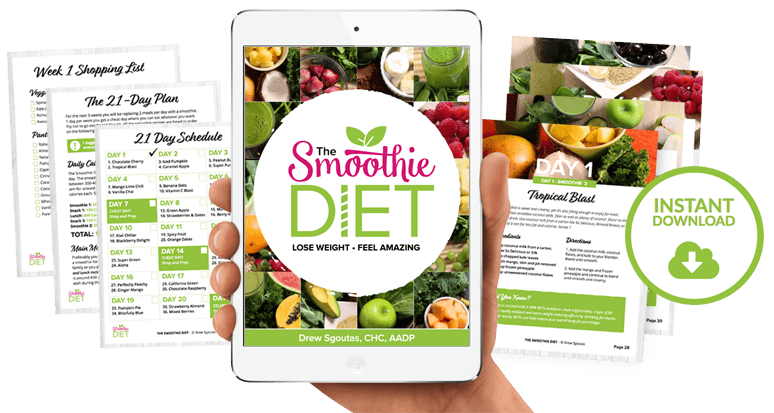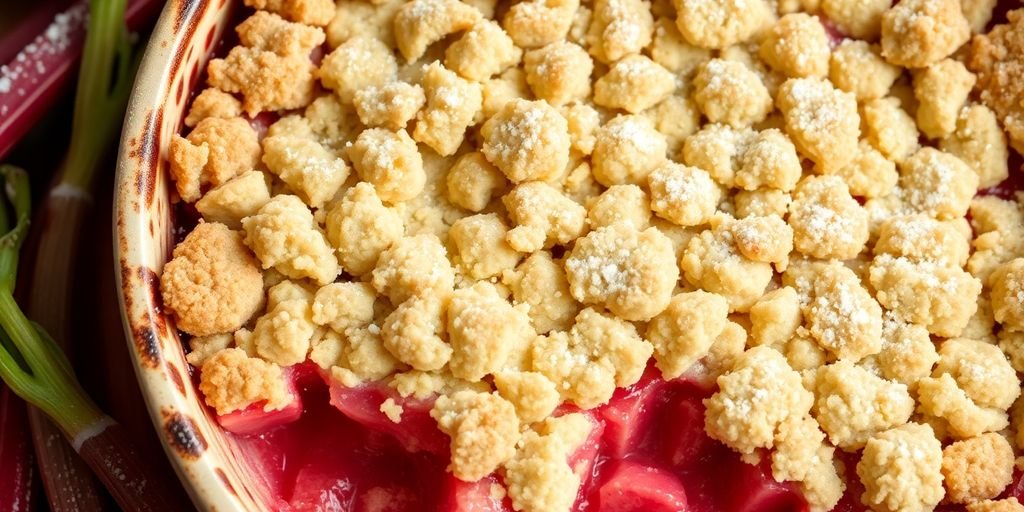Rhubarb crumble is a beloved British dessert that perfectly balances sweet and tart flavors. This dish has a classic appeal, thanks to its crunchy topping and delicious filling. Whether you’re a seasoned baker or just trying it for the first time, perfecting your rhubarb crumble is easier than you might think. With the right ingredients and techniques, you’ll be serving up this comforting dessert in no time.
Key Takeaways
- Choose fresh, vibrant rhubarb for the best flavor.
- Keep your butter cold to achieve a crispy crumble topping.
- Layer the crumble loosely over the filling for better texture.
- Avoid overmixing to prevent a greasy topping.
- Serve with custard, ice cream, or clotted cream for a delightful treat.
Essential Ingredients For Rhubarb Crumble

Choosing The Right Rhubarb
Okay, so rhubarb is the star here, right? But not all rhubarb is created equal. You want stalks that are firm and crisp, not limp or bendy. The color can vary from pink to green, and honestly, it doesn’t make a huge difference in taste. Just make sure they look fresh. Forced rhubarb, which is grown indoors, tends to be a bit sweeter and more tender, so if you can find it, go for it! Otherwise, regular garden rhubarb will work just fine. Just give it a good wash and trim off the leaves (they’re poisonous, so seriously, don’t eat them).
Sugar Variations
Sugar is key to balancing out the tartness of the rhubarb. Plain white sugar is fine, but I like to mix things up a bit. Golden caster sugar adds a nice caramel-y note. Brown sugar works too, for a deeper, molasses-like flavor. And if you’re feeling fancy, a sprinkle of demerara sugar on top of the crumble adds a lovely crunch. It’s really about personal preference, so experiment and see what you like best. Just don’t skimp on the sugar altogether, or you’ll end up with a super sour rhubarb crumble that’ll make your face pucker.
Butter Types For Crumble
Butter is what makes the crumble topping, well, crumbly. Cold butter is the secret here – it creates pockets of air that give you that perfect, slightly crunchy texture. Unsalted butter is my go-to, because it lets you control the amount of salt in the recipe. But salted butter works too, just reduce the amount of salt you add separately. Some people swear by using a mix of butter and shortening for an extra tender crumble, but I’m a butter purist myself. Just make sure it’s good quality butter, because it really does make a difference in the final taste.
Using cold butter is really important. I like to cut it into small cubes and then pop it back in the fridge for a few minutes before I start making the crumble. This helps to keep it from melting too quickly and gives you a much better texture.
Techniques For Perfecting Your Crumble

Keeping Ingredients Cold
Seriously, don’t skip this step! Cold ingredients are the secret weapon for a truly great crumble. When the butter is cold, it doesn’t melt into the flour as easily, which is what gives you those lovely, distinct crumbs instead of a greasy mess. I like to cube my butter and then pop it back in the freezer for about 10-15 minutes before I start. It makes a world of difference. Also, if your kitchen is warm, consider chilling the flour too. It might sound a bit extra, but trust me, it’s worth it.
Avoiding Overmixing
Overmixing is the enemy of a good crumble. You want to mix the butter and flour just enough so that it resembles coarse breadcrumbs. If you overwork it, the gluten in the flour develops, and you end up with a tough, dense topping instead of a light, crumbly one. I find using my fingertips is the best way to get the right texture.
Think of it like making pastry – you want to be gentle and quick. Don’t knead the mixture; just rub the butter into the flour until you get those nice crumbs. If you’re using a food processor, pulse it in short bursts to avoid overdoing it.
Layering The Crumble
How you layer the crumble can really affect the final result. Don’t just dump the topping on top of the rhubarb. Instead, gently sprinkle it over, making sure to cover the entire surface. You want some gaps for the heat to circulate, which helps the topping crisp up nicely. I also like to add a little extra demerara sugar on top for extra crunch and sweetness. It creates a beautiful golden crust that’s just irresistible. And remember, don’t press the crumble down! You want it to stay light and airy.
Serving Suggestions For Rhubarb Crumble

Pairing With Custard
Okay, so you’ve got this amazing rhubarb crumble fresh out of the oven. What’s next? Well, for me, it’s all about the custard. A warm, creamy custard is the perfect counterpoint to the tartness of the rhubarb. It’s like they were made for each other. You can go classic with a vanilla custard, or get a little fancy and try a custard infused with almond or even a hint of orange. Honestly, any good custard will do the trick. It’s the ultimate comfort food combo. Don’t skimp on the custard, either. You want a generous pour over that warm crumble. For a quick and easy dessert, try these dessert recipes.
Serving With Ice Cream
If custard isn’t your thing (gasp!), don’t worry, ice cream is an equally awesome choice. The coldness of the ice cream against the warm crumble is just chef’s kiss. Vanilla is a classic, safe bet, but don’t be afraid to experiment. A scoop of ginger ice cream can really complement the rhubarb, or maybe even a salted caramel for a bit of extra indulgence. I’ve even tried it with a scoop of rhubarb and ginger ice cream, which was rhubarb overload in the best way possible. Just make sure the ice cream is good quality – it makes all the difference.
Enjoying With Clotted Cream
Now, if you really want to take your rhubarb crumble to the next level, you’ve gotta try it with clotted cream. This is a British thing, and it’s seriously amazing. Clotted cream is super thick and rich, almost like a cross between butter and whipped cream. It adds a luxuriousness to the crumble that you just can’t get with anything else. It’s definitely a treat, but it’s so worth it. You can usually find it at specialty stores or online. Just a dollop on top of your warm crumble is all you need. Trust me, you won’t regret it. It’s the perfect way to end a cozy evening. Here are some serving suggestions for your crumble:
- Warm, straight from the oven
- Slightly cooled, for a more defined texture
- Even cold, the next day (if there are any leftovers!)
Serving rhubarb crumble is more than just putting it on a plate. It’s about creating an experience. Whether it’s the warmth of the custard, the coolness of the ice cream, or the richness of the clotted cream, each addition enhances the flavors and textures of the crumble. It’s a simple dessert, but with the right accompaniments, it can be truly special.
Common Mistakes To Avoid
Balancing Sweetness And Tartness
Okay, so rhubarb is tart. That’s its thing. But a crumble that’s too tart? Nobody wants that. The key is finding the right balance with your sweetener. I usually start with a smaller amount of sugar and then taste as I go, adding more until it hits that sweet spot. It’s a bit of an art, not a science, and depends on how tart your rhubarb is and how sweet you like your desserts. Don’t be afraid to experiment a little!
Preventing A Soggy Crust
Ugh, the dreaded soggy bottom! It’s happened to the best of us. Here’s the deal: moisture is the enemy.
- Make sure your rhubarb isn’t too wet after you chop it. Pat it dry with paper towels if needed.
- Toss the rhubarb with a bit of cornstarch or flour before adding the sugar. This helps absorb excess juices.
- Don’t let the crumble sit for too long before baking. The longer it sits, the more moisture it will draw out.
I once made a rhubarb crumble and let it sit in the fridge overnight before baking. Big mistake! The crust was a total disaster. Now I always bake it right away, or at least within a couple of hours.
Using The Right Baking Dish
Dish size matters! Too big, and your crumble will be thin and sad. Too small, and you risk overflow. A good rule of thumb is to use a dish that’s about 9×13 inches for a standard recipe. Also, the material of the dish can affect baking time. Glass dishes tend to heat up more slowly than metal ones. If you’re using glass, you might need to add a few extra minutes to the baking time. For those looking for gluten-free baking recipes, consider how the dish impacts the overall texture and cooking time.

Making Rhubarb Crumble Ahead Of Time
Preparing The Filling
You can totally get a head start by prepping the rhubarb filling in advance. Just chop your rhubarb, mix it with sugar, vanilla extract, cinnamon, and a pinch of salt, then stash it in an airtight container in the fridge. I wouldn’t leave it for more than 24 hours, though, or it might get a little too mushy. When you’re ready to bake, just pour it into your baking dish. This is a great way to save time, especially if you’re making rhubarb crumble for a dinner party.
Storing The Crumble Topping
The crumble topping is another component you can prep ahead. Mix your flour, butter, sugar, and any spices you’re using, then either keep it in a sealed bag or container in the fridge for a few days, or freeze it for longer storage. If you freeze it, just break it up with your fingers before using it. This way, you can have it ready to go whenever the craving strikes.
Reheating Tips
Okay, so you’ve baked your rhubarb crumble, but you have leftovers (if you’re lucky!). Here’s the deal: it’s best fresh, but reheating works.
- Microwave: Quick and easy, but the crumble might get a bit soft.
- Oven: Reheat at a low temperature (around 300°F) for about 15-20 minutes to crisp it up again.
- Air Fryer: A good option for crisping up the topping without drying out the filling.
I wouldn’t recommend baking the crumble completely the day before if you’re serving it to guests, as it loses some of its charm. However, reheated crumble is still delicious, especially with a dollop of custard or ice cream. It’s a comforting treat any time of day!
Variations On The Classic Rhubarb Crumble

Adding Spices Like Ginger
Okay, so you’ve mastered the basic rhubarb crumble. What’s next? Let’s spice things up! Adding spices can really transform your crumble. Ginger is a classic pairing with rhubarb, bringing a warm, slightly spicy note that complements the tartness. I usually add about a teaspoon of ground ginger to the rhubarb filling, but you can also use fresh, grated ginger for a more intense flavor. Other spices to consider include cinnamon, nutmeg, or even a pinch of cardamom. It’s all about experimenting to find your perfect blend. Don’t be afraid to try a festive treat this holiday season.
Incorporating Other Fruits
Who says rhubarb has to go it alone? Rhubarb plays well with others, especially other fruits. Apples and rhubarb are a match made in heaven, creating a sweet-tart combination that’s hard to resist. Berries, like strawberries or raspberries, also work beautifully, adding extra sweetness and a vibrant color. Stone fruits, such as plums or peaches, can bring a lovely depth of flavor. When adding other fruits, adjust the sugar accordingly, as some fruits are naturally sweeter than others. Here’s a simple guide:
- Apples: Use about 2 medium apples, peeled and chopped.
- Berries: Add about 1 cup of mixed berries.
- Stone Fruits: Use about 3 plums or peaches, pitted and sliced.
I once tried adding a handful of chopped crystallized ginger to my apple and rhubarb crumble, and it was a game-changer. The little bursts of sweetness and spice were amazing!
Experimenting With Toppings
The crumble topping is where you can really get creative. While the classic flour, butter, and sugar combo is always a winner, there are tons of ways to mix it up. Consider adding oats for a chewier texture, or nuts for extra crunch. A sprinkle of demerara sugar on top will give it a lovely caramelized finish. You could even try using different types of flour, like almond flour or whole wheat flour, for a unique flavor and texture. Here are some ideas:
- Add 1/2 cup of rolled oats for a chewier topping.
- Mix in 1/4 cup of chopped nuts (almonds, pecans, or walnuts).
- Use brown sugar instead of white sugar for a richer flavor.
- Try adding a pinch of salt to the topping to balance the sweetness.
The History Of Rhubarb Crumble
Origins Of Rhubarb
So, rhubarb. It’s not exactly the first thing that springs to mind when you think of classic British desserts, right? But it’s got a surprisingly interesting backstory. Rhubarb actually originated in Asia, specifically Siberia. It wasn’t initially used for food; instead, it was valued for its medicinal properties. Imagine that – a dessert ingredient that started as a health remedy! It took a while for rhubarb to make its way to Europe, and even longer for people to figure out it could be more than just a medicine. Now you can even find local farmers markets selling rhubarb.
Evolution Of The Crumble
Okay, let’s talk about the crumble part of the equation. The crumble topping, as we know it, is a relatively recent invention. Before World War II, people in Britain often made crumbles because they were a cheap alternative to pies, which required more flour and fat for the pastry crust. The crumble was a way to make the most of limited resources. It’s funny to think that something born out of necessity has become such a beloved treat. It’s a testament to how resourceful people can be in the kitchen.
Cultural Significance In Britain
Rhubarb crumble isn’t just a dessert; it’s a cultural icon in Britain. It’s the kind of thing that reminds people of their childhood, of family dinners, and of simpler times. It’s often served with custard, ice cream, or clotted cream – each family has their own favorite way to enjoy it. Rhubarb crumble is more than just a recipe; it’s a piece of British history, a symbol of comfort, and a reminder of the sweet and sour fruit that makes it so special.
It’s interesting how a simple dish can carry so much cultural weight. Rhubarb crumble represents resourcefulness, family traditions, and the ability to find joy in simple pleasures. It’s a dessert that tells a story, and that’s what makes it so special.
Here are some reasons why it’s so popular:
- It’s easy to make.
- It uses readily available ingredients.
- It’s adaptable to different tastes.
Wrapping Up Your Rhubarb Crumble Journey
So there you have it! Perfecting your rhubarb crumble isn’t just about following a recipe; it’s about finding that balance of sweet and tart, and getting that crumble just right. Remember, don’t stress too much if it doesn’t come out perfect the first time. Cooking is all about experimenting and having fun. Whether you serve it warm with custard or cold with yogurt, it’s hard to go wrong with this classic dessert. So, grab some rhubarb, get your hands a little messy, and enjoy the process. Happy baking!
Frequently Asked Questions
What type of rhubarb should I use for crumble?
Look for fresh, vibrant rhubarb stalks that are firm and not wilted. The pink or red varieties are sweeter and perfect for crumble.
How can I adjust the sweetness of my rhubarb crumble?
You can add more or less sugar depending on how sweet or tart your rhubarb is. Taste the filling before baking and adjust the sugar accordingly.
What kind of butter is best for the crumble topping?
Use cold unsalted butter for the best results. It helps create a nice, crumbly texture.
How do I prevent my crumble from being soggy?
Make sure to layer the crumble topping loosely over the fruit. Avoid pressing it down too hard.
Can I make rhubarb crumble in advance?
Yes! You can prepare the rhubarb filling and the crumble topping ahead of time. Just store them separately in the fridge and assemble before baking.
What are some good toppings to serve with rhubarb crumble?
Rhubarb crumble is delicious with vanilla custard, ice cream, or clotted cream. Choose your favorite for a delightful dessert!


